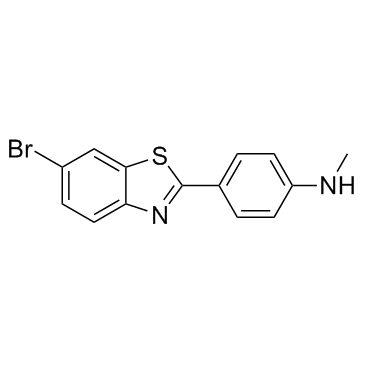4-(6-Bromo-2-benzothiazolyl)-N-methylbenzenamine |
| カタログ番号GC30952 |
4-(6-ブロモ-2-ベンゾチアゾリル)-N-メチルベンゼンアミンは、1.7 nM の KD でアミロイド-β (1-40) に結合する強力なアミロイド イメージング エージェントです。
Products are for research use only. Not for human use. We do not sell to patients.

Cas No.: 566169-98-0
Sample solution is provided at 25 µL, 10mM.
4-(6-Bromo-2-benzothiazolyl)-N-methylbenzenamine is a potent amyloid imaging agent which binds to Amyloid-β (1-40) with a KD of 1.7 nM.
Alzhermer's Disease (AD) is a neurodegenerative illness characterized by memory loss and other cognitive deficits. The ability to quantify amyloid load before treatment is critical to the efficient development of this class of drugs[2]. Brain entry in control mice and baboons is high for 4-(6-Bromo-2-benzothiazolyl)-N-methylbenzenamine. Staining of AD frontal cortex tissue sections with 4-(6-Bromo-2-benzothiazolyl)-N-methylbenzenamine indicates the selective binding of the compound to amyloid plaques and cerebrovascular amyloid. The encouraging properties of the compound support the choice of this derivative for further evaluation in human subject studies of brain Amyloid-βdeposition. The brain radioactivity concentrations (%ID-kg/g) of 4-(6-Bromo-2-benzothiazolyl)-N-methylbenzenamine is remarkably similar in mice and baboons (0.21 vs 0.27). The rate of clearance of radioactivity is considerably slower from baboon brain than from mouse brain, although the rank order of clearance rate is similar in mice and baboons. The tissue staining findings utilizing nonradiolabeled, fluorescent 4-(6-Bromo-2-benzothiazolyl)-N-methylbenzenamine are similar to those reported for BTA-1. Both amyloid plaques and cerebrovascular amyloid are stained by 4-(6-Bromo-2-benzothiazolyl)-N-methylbenzenamine in a manner similar to serial sections stained with an antibody to Amyloid-β, and relatively little tissue background staining is observed[1].
[1]. Mathis CA, et al. Synthesis and evaluation of 11C-labeled 6-substituted 2-arylbenzothiazoles as amyloid imaging agents. J Med Chem. 2003 Jun 19;46(13):2740-54. [2]. Klunk W, et al. Amyloid imaging as a surrogate marker for efficacy of anti-amyloid therapies.
Animal experiment: | Mice[1]Studies are performed in female Swiss-Webster mice (23-35 g). The mice are injected in a lateral tail vein with 0.37-3.7 MBq (10-100 µCi) of a high specific activity (>7.4 GBq/µmol) 11C-4-(6-Bromo-2-benzothiazolyl)-N-methylbenzenamine contained in <0.10 mL of a solution of 93% isotonic saline and 7% ethanol. The mice are anesthetized and killed by cardiac excision following cardiac puncture to obtain arterial blood samples at 2 or 30 min postinjection. The mouse brains are rapidly excised and divided into cerebellum and remaining whole brain (including brain stem) fractions. The brain samples are counted in a gamma wellcounter, and the counts are decay-corrected to the time of injection relative to 11C standards prepared from the injection solution to determine the percent injected dose (%ID) in the samples. The brain samples are weighed to determine the percent injected dose per gram tissue (%ID/g), and this quantity is multiplied by the whole body weight (in kg) to determine the body-weight normalized radioactivity concentration [(%ID-kg)/g] of each tissue sample[1]. |
References: [1]. Mathis CA, et al. Synthesis and evaluation of 11C-labeled 6-substituted 2-arylbenzothiazoles as amyloid imaging agents. J Med Chem. 2003 Jun 19;46(13):2740-54. | |
| Cas No. | 566169-98-0 | SDF | |
| Canonical SMILES | CNC1=CC=C(C2=NC3=CC=C(Br)C=C3S2)C=C1 | ||
| Formula | C14H11BrN2S | M.Wt | 319.22 |
| 溶解度 | Soluble in DMSO | Storage | Store at -20°C |
| General tips | Please select the appropriate solvent to prepare the stock solution according to the
solubility of the product in different solvents; once the solution is prepared, please store it in
separate packages to avoid product failure caused by repeated freezing and thawing.Storage method
and period of the stock solution: When stored at -80°C, please use it within 6 months; when stored
at -20°C, please use it within 1 month. To increase solubility, heat the tube to 37°C and then oscillate in an ultrasonic bath for some time. |
||
| Shipping Condition | Evaluation sample solution: shipped with blue ice. All other sizes available: with RT, or with Blue Ice upon request. | ||
| Prepare stock solution | |||

|
1 mg | 5 mg | 10 mg |
| 1 mM | 3.1326 mL | 15.6632 mL | 31.3264 mL |
| 5 mM | 0.6265 mL | 3.1326 mL | 6.2653 mL |
| 10 mM | 0.3133 mL | 1.5663 mL | 3.1326 mL |
Step 1: Enter information below (Recommended: An additional animal making an allowance for loss during the experiment)
 g
g
 μL
μL

Step 2: Enter the in vivo formulation (This is only the calculator, not formulation. Please contact us first if there is no in vivo formulation at the solubility Section.)
Calculation results:
Working concentration: mg/ml;
Method for preparing DMSO master liquid: mg drug pre-dissolved in μL DMSO ( Master liquid concentration mg/mL, Please contact us first if the concentration exceeds the DMSO solubility of the batch of drug. )
Method for preparing in vivo formulation: Take μL DMSO master liquid, next addμL PEG300, mix and clarify, next addμL Tween 80, mix and clarify, next add μL ddH2O, mix and clarify.
Method for preparing in vivo formulation: Take μL DMSO master liquid, next add μL Corn oil, mix and clarify.
Note: 1. Please make sure the liquid is clear before adding the next solvent.
2. Be sure to add the solvent(s) in order. You must ensure that the solution obtained, in the previous addition, is a clear solution before proceeding to add the next solvent. Physical methods such as vortex, ultrasound or hot water bath can be used to aid dissolving.
3. All of the above co-solvents are available for purchase on the GlpBio website.
Quality Control & SDS
- View current batch:
- Purity: >98.00%
- COA (Certificate Of Analysis)
- SDS (Safety Data Sheet)
- Datasheet
Average Rating: 5 (Based on Reviews and 34 reference(s) in Google Scholar.)
GLPBIO products are for RESEARCH USE ONLY. Please make sure your review or question is research based.
Required fields are marked with *



















